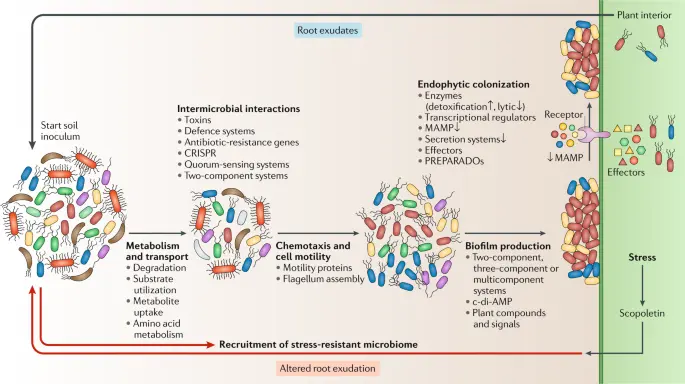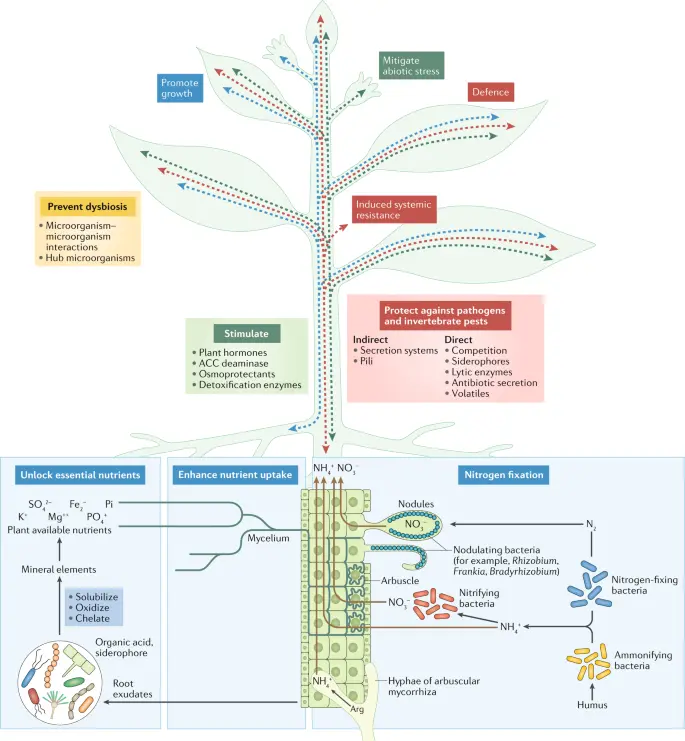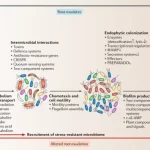Plant Microbiome 101
Introduction to Plant Microbiome Interactions
Welcome to Part 2 of our exploration into the wondrous world of plant microbiomes. Our previous blog, “Plant Microbiome 101: Introduction to a Plant Microbial Universe,” introduced the basics of the plant microbial universe. Now, let’s delve deeper into the fascinating processes of plant colonization and the critical functions of plant-associated microbiomes. Whether you’re a hydroponic enthusiast or a traditional soil grower, understanding these aspects will revolutionize your plant care and cultivation approach.
Key Terms:
Colonization: for the topic of plant microbiomes, we are talking about how microorganisms (like bacteria and fungi, etc.) find and settle around, on and within a host plant.
Plant stress: environmental (drought, high salinity. etc.) or biological (pests, disease, etc.) conditions that slow or damage plant health and development.
Interactions: a term used to describe the effects organisms in a community have on each other, such as competition, mutualism, antagonism, etc.
Want more plant-microbial content? You can subscribe here:
Plant Colonization and Community Assembly
Picture plants as thriving cities and microbes (like bacteria and fungi) as their citizens. Just like a city has a diverse population with different jobs, plants host a range of microbes that perform different functions. For the microbes to colonize the plant, they need to arrive and settle in. The following are the stages of colonization:
- Seed Transmission: The journey begins even before germination, with certain microbes transmitted from the parent plant via seeds. These early colonizers are crucial for the initial stages of plant development.
- Rhizosphere Recruitment: As seeds germinate, the root-associated microbiome dynamically assembles. Soil-dwelling microorganisms are recruited to the rhizosphere (the root surface area) and root endosphere (inside the roots), influenced by root exudates – a cocktail of sugars, acids, and other compounds that attract specific microbes.

The roots of the plants release special substances, which attract these microbes from the soil. Once they arrive, they start setting up their little microbial communities around and inside the roots of the plant. However, many factors influence which microorganisms can colonize and how they act. Here are the factors influencing the assembly of the microbial community:
- Host Plant Traits: The plant’s genetic makeup and physical characteristics help shape its associated microbial community.
- Environmental Conditions: Temperature, humidity, soil or substrate type, and even farming practices impact microbial community composition.
- Inter-Microbial Interactions: Microbes interact with each other through competition, cooperation, and even predation.
Some microbes are like bodyguards, protecting the plant from harmful germs. Other microbes help the plant handle tough times (plant stress), like when there’s not enough water. Others are like food processing units, producing important food for the plant by making it in a form that is available for the plant to take. The plant and microbes communicate using chemical signals.
Functions of Plant Microbiomes

Growth Promotion and Nutrient Uptake (Blue):
Microorganisms in the plant microbiome solubilize, oxidize or chelate mineral elements to more plant-available forms. Furthermore, bacteria specifically play a key role in making nitrates and ammonia that can be taken in by the plant. Microorganisms also produce growth hormones that contribute to plant development.
- Auxins:
- Auxins, particularly Indole-3-acetic acid (IAA), are one of the most well-known plant growth hormones produced by microbes.
- They play a crucial role in cell elongation, root development, and overall growth of the plant.
- Microbes producing auxins can enhance root growth, which helps the plant absorb more water and nutrients.
- Gibberellins:
- Gibberellins are another group of hormones produced by certain fungi and bacteria.
- They are involved in several aspects of plant growth, including seed germination, stem elongation, and flowering.
- Microbial-produced gibberellins can help plants overcome stress conditions like cold temperatures.
- Cytokinins:
- Cytokinins, produced by some bacteria, are important for cell division and differentiation, as well as the growth of shoot systems.
- They also play a role in leaf senescence (aging) and can delay it, keeping the plant greener and healthier for longer.
- These hormones can enhance nutrient mobilization, leading to better growth and yield.
- Ethylene:
- Some microbes can indirectly influence the levels of ethylene in plants. Though ethylene is usually produced by the plants themselves, microbial activity can modulate its production.
- Ethylene is involved in various plant processes, including fruit ripening and response to stress.
Stress Tolerance (Green):
Microbes in the plant microbiome can enhance a plant’s resistance to various stresses like drought, salinity, and heavy metals via ACC deaminase, osmoprotectants, detoxification enzymes and other plant hormones. More specifically, ACC deaminase helps regulate the ethylene signalling pathway by degrading the precursor to the stress hormone ethylene. Without ethylene, there is no stress signal, and the plant does not perceive stress. Other protective mechanisms involve:
- Osmoprotectants:
- Small molecules that plants produce to protect themselves against stress caused by extreme conditions like drought, high salt in the soil, or extreme temperatures.
- They work by balancing the amount of water inside plant cells, preventing them from drying out or getting damaged. It’s like having a built-in water regulator.
- Common osmoprotectants include substances like proline, glycine betaine, and trehalose.
- Detoxification Enzymes:
- When plants are stressed, they can produce harmful molecules called reactive oxygen species (ROS)
- Detoxification enzymes neutralize these harmful ROS, preventing damage to the plant’s cells.
- Important detoxification enzymes include superoxide dismutase, catalase, and peroxidase. They’re like firefighters putting out fires in the cells.
- Plant Hormones:
- Hormones are like messengers in the plant’s body, sending signals to help the plant respond to different conditions.
- Several hormones play a role in stress response:
- Abscisic Acid (ABA): ABA helps plants conserve water during drought and plays a role in seed dormancy and germination.
- Ethylene: While it’s known for its role in fruit ripening, ethylene is also produced in response to stress. ACC deaminase shuts down this stress response pathway.
- Salicylic Acid: This hormone is key in the plant’s defence against pathogens. It’s like the plant’s alarm system against disease.
- Jasmonic Acid: Involved in the plant’s defence against insect attacks and wound healing.
- Cytokinins, Auxins, and Gibberellins: These hormones also get involved during stress, often helping to regulate growth and development so the plant can better withstand unfavourable conditions.
Disease Resistance (Red):
Beneficial microbes can suppress plant pathogens through direct competition or by producing antimicrobial compounds. They also ready the plant’s immune system (a process called Induced Systemic Resistance), preparing it to better defend against potential pathogens.
Applying This Knowledge in Hydroponics and Soil Cultivation:
Hydroponic Systems:
- Emphasize creating microbe-friendly environments by regulating nutrient solutions, pH, and temperature.
- Introduce beneficial microbes through inoculants to enhance nutrient uptake and disease resistance.
- Monitor microbial populations regularly to maintain a balanced ecosystem.
Soil Cultivation:
- Foster a diverse and healthy soil microbiome through organic practices and minimal soil disturbance.
- Utilize compost and other organic amendments to introduce beneficial microbes.
- Pay attention to crop rotation and cover cropping to maintain microbial diversity and soil health.
Conclusion:
The world beneath our plants’ roots is bustling with activity that is crucial for their health and productivity. By understanding and harnessing the power of plant-associated microbiomes, we can grow healthier plants and achieve more sustainable cultivation practices. Don’t forget to subscribe to our blog for more plant microbial content. Happy growing!
If you would like to read the review yourself, there is an online version available to read here.
Banner image from Trivedi et al. 2020. https://www.nature.com/articles/s41579-020-0412-1
References
Trivedi, P., Leach, J.E., Tringe, S.G. et al. Plant–microbiome interactions: from community assembly to plant health. Nat Rev Microbiol 18, 607–621 (2020). https://doi.org/10.1038/s41579-020-0412-1
![]()
David Santos is the COO/CMO of Healthy Hydroponics InnoTech




